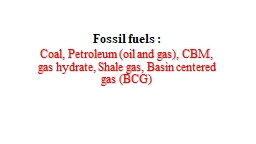

centered gas BCG COALS Accumulation of plant debris protection from decay by rapid burial With burial first combustible product is peat further burial increase in PT and time peat converts to soft brown coal called ID: 1021520
Download Presentation The PPT/PDF document "Fossil fuels : Coal, Petroleum (oil an..." is the property of its rightful owner. Permission is granted to download and print the materials on this web site for personal, non-commercial use only, and to display it on your personal computer provided you do not modify the materials and that you retain all copyright notices contained in the materials. By downloading content from our website, you accept the terms of this agreement.
1. Fossil fuels : Coal, Petroleum (oil and gas), CBM, gas hydrate, Shale gas, Basin centered gas (BCG)
2. COALSAccumulation of plant debris, protection from decay by rapid burialWith burial, first combustible product is peat, further burial, increase in P,T and time, peat converts to soft brown coal, called lignite, further burial converts to harder coal (bituminous and anthracite).Normally when plants die, they react with oxygen in the atmosphere to form carbon dioxide and water, which return to the atmosphere. If they are buried before oxidation occurs, the organic matter can be fossilized and turned to coal.
3. The largest formation of coal occurred during the Carboniferous Period (~300 million years ago), where coastal plains with lush vegetation growing at low latitudes were buried beneath deltaic sands as shorelines transgressed and regressed, probably as a result of the growth and retreat of continental ice sheets in high latitudes.
4. The changes that occur during burial, diagenesis, and eventually low-grade metamorphism are used to classify coal into rank , Low-rank coal is commonly referred to as lignite or brown coal . Intermediate rank coal is referred to as bituminous . It is blacker than lignite and prominently layered on the millimeter scale with material of different reflectance and fracture. The highest-rank coal is anthracite, It appears almost metallic and breaks with a conchoidal fracture. It is massive and lacks the fine laminations of bituminous coal.Cannel coal is another variety that is fine-grained, massive, and has conchoidal fracture, but unlike anthracite, it has a greasy luster.
5. Land plants evolved only in the Silurian, so coal does not occur in older rocks. In fact, it is quite rare in rocks older than the Carboniferous.It forms beds that are usually less than a meter thick but can be laterally extensive. Coal is our largest reserve of fossil fuel and will be used more in the future as reserves of oil decrease.
6. Non-renewable deposits
7. OIL AND NATURAL GAS
8. 1.GENERATION OF PETROLEUM IN SOURCE ROCKSAccumulation of organic matter, quick burial of organic matter, so that decay by biological means and reaction with oxygen which will destroy the org matter, can be avoided.With burial, organic matter called kerogen begin to change, reactions take place to break large complex org molecules to simpler, smaller hydrocarbons, nature of hydrocar changes with time and P,T, and produces petroleum oil and gas. Black shales are the most common source rock for hydrocarbons.
9. 2.MIGRATION OF PETROLEUM The oil and gas migrate through pores and fractures 3.TRAP/ ACCUMULAIONTrapped/accumulated in a suitable place, called reservoir rocks, from where they are extracted. Reservoir rocks must have high porosity and the pores should have a high degree of connectedness, that is, high permeability.Poorly cemented sandstones and carbonate rocks are the most common reservoir rocks. Oil and gas are both less dense than water and, therefore, tend to rise toward the surface. For them to be kept in a reservoir rock, they must be confi ned by an impermeable cap rock whose configuration creates a natural trap for the buoyant hydrocarbons.
10.
11. SHALE GASShale gas is natural gas that is found trapped within shale formations. Shale gas has become an increasingly important source of natural gas. Shales are fine-grained sedimentary rocks that can be rich sources of petroleum and natural gas. Has very less permeability.
12. Horizontal Drilling and Hydraulic FracturingOver the past decade, the combination of horizontal drilling and hydraulic fracturing has allowed access to large volumes of shale gas that were previously uneconomical to produce. The U.S. Has Abundant Shale Gas Resources Enough for 110 Years of UseShale gas is one of the most rapidly growing forms of natural gas. It, along with other non-conventional forms of natural gas, such as tight gas and coalbed methane, will make a major contribution to future .
13.
14. Shale gas may be recoverable through a process known as "fracking". Hydraulic fracturing, or fracking, is a technique designed to recover gas and oil from shale rockHydraulic fracturing (also hydrofracturing, hydrofracking, fracking, or fraccing) is a well-stimulation technique in which rock is fractured by a pressurized liquid. The process involves the high-pressure injection of 'fracking fluid' (primarily water, containing sand).
15. COALBED METHANECoalbed methane (CBM or coal-bed methane), coalbed gas, coal seam gas (CSG), or coal-mine methane (CMM) is a form of natural gas extracted from coal beds. In recent decades it has become an important source of energy in United States, Canada, Australia, and other countries
16.
17. Gas hydrate is a solid ice-like form of water that contains gas molecules in its molecular cavities. In nature, this gas is mostly methane. Methane gas hydrate is stable at the seafloor at water depths beneath about 500 m
18. Tight gas is natural gas produced from reservoir rocks with such low permeability that massive hydraulic fracturing is necessary to produce the well at economic rates. Basin-centered gas accumulations (BCG) are typically characterized by regionally pervasive accumulations that are gas saturated, abnormally pressured, commonly lack a downdip water contact, and have low-permeability reservoirs.
19.